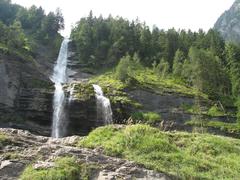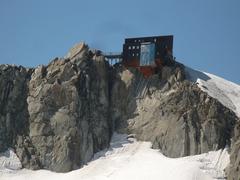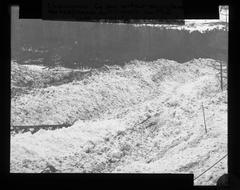Visiting Guide for 907, Chamonix-Mont-Blanc, France: Hours, Tickets, and More
Last Updated Date: 23/07/2024
Introduction to 907, Chamonix-Mont-Blanc
Nestled in the heart of the French Alps, Chamonix-Mont-Blanc offers a compelling blend of rich history, cultural significance, and natural beauty. Established by early Celtic settlers around 1091 AD, the town has evolved into a premier destination for mountaineers, skiers, and tourists alike. The ascension of Mont Blanc, Western Europe’s highest peak at 4,808 meters, marked the birth of modern alpinism in 1786 when Jacques Balmat and Dr. Michel-Gabriel Paccard reached its summit. This monumental achievement, along with the town hosting the first Winter Olympics in 1924, has cemented Chamonix’s status in the annals of history (Exploring Chamonix-Mont-Blanc).
Today, Chamonix is more than just a hub for outdoor enthusiasts; it is a vibrant community that preserves its historical legacy while embracing modern innovation. The town’s architectural beauty, characterized by traditional alpine chalets, stands alongside contemporary amenities like the Mont Blanc Tunnel and various cable cars. Cultural events such as the Ultra-Trail du Mont-Blanc and the Cosmojazz Festival add to its allure, making it a year-round destination with activities for every season (Ultimate Visitor Tips for Chamonix-Mont-Blanc).
This comprehensive guide delves into the multifaceted significance of Chamonix-Mont-Blanc, offering practical visitor information, historical insights, and travel tips to ensure a memorable visit.
Table of Contents
- [Introduction](#introductionintroduction-to-907-chamonix-mont-blanc)
- [History of Chamonix-Mont-Blanc](#history-of-chamonix-mont-blanchistory-of-chamonix-mont-blanc)
- [Early Settlement and Medieval Period](#early-settlement-and-medieval-periodearly-settlement-and-medieval-period)
- [Development in the 18th Century](#development-in-the-18th-centurydevelopment-in-the-18th-century)
- [The Birth of Alpinism](#the-birth-of-alpinismthe-birth-of-alpinism)
- [19th Century – The Golden Age of Mountaineering](#19th-century—the-golden-age-of-mountaineering19th-century-the-golden-age-of-mountaineering)
- [20th Century – Tourism and Winter Sports](#20th-century—tourism-and-winter-sports20th-century-tourism-and-winter-sports)
- [Modern Era – A Blend of Tradition and Innovation](#modern-era—a-blend-of-tradition-and-innovationmodern-era-a-blend-of-tradition-and-innovation)
- [Preservation of Historical Heritage](#preservation-of-historical-heritagepreservation-of-historical-heritage)
- [Cultural Significance](#cultural-significancecultural-significance)
- [Historical Figures and Their Legacy](#historical-figures-and-their-legacyhistorical-figures-and-their-legacy)
- [Impact of World Wars](#impact-of-world-warsimpact-of-world-wars)
- [Environmental Conservation](#environmental-conservationenvironmental-conservation)
- [Visitor Information](#visitor-informationvisitor-information)
- [Visiting Hours and Ticket Prices](#visiting-hours-and-ticket-pricesvisiting-hours-and-ticket-prices)
- [Travel Tips](#travel-tipstravel-tips)
- [Nearby Attractions](#nearby-attractionsnearby-attractions)
- [Special Events and Guided Tours](#special-events-and-guided-toursspecial-events-and-guided-tours)
- [Photographic Spots](#photographic-spotsphotographic-spots)
- [FAQ](#faqfaq)
- [Conclusion](#conclusionconclusion)
- [Sources and Further Reading](#sources-and-further-readingsources-and-further-reading)
History of Chamonix-Mont-Blanc
Early Settlement and Medieval Period
Chamonix-Mont-Blanc, often referred to simply as Chamonix, is a historic town nestled in the French Alps. The earliest known settlers in the Chamonix Valley were the Celts, who arrived around 1091 AD. The valley was later granted to the Benedictine monks of the Abbey of Saint-Michel-de-la-Cluse by the Count of Geneva. The monks established a priory and began cultivating the land, which marked the beginning of Chamonix’s recorded history.
Development in the 18th Century
The 18th century was a pivotal period for Chamonix. In 1741, two Englishmen, William Windham and Richard Pococke, visited the valley and documented their journey. Their accounts, published in the ‘Philosophical Transactions of the Royal Society,’ sparked interest in the region among European aristocrats and adventurers. This period marked the beginning of Chamonix’s transformation from a remote mountain village to a destination for explorers and scientists.
The Birth of Alpinism
The ascent of Mont Blanc, the highest peak in Western Europe at 4,808 meters (15,774 feet), is a significant chapter in Chamonix’s history. On August 8, 1786, Jacques Balmat and Dr. Michel-Gabriel Paccard successfully reached the summit, marking the birth of modern alpinism. This achievement attracted more climbers and adventurers to Chamonix, establishing it as a premier destination for mountaineering.
19th Century - The Golden Age of Mountaineering
The 19th century saw Chamonix flourish as a hub for mountaineering. The establishment of the Compagnie des Guides de Chamonix in 1821, the world’s first mountain guide company, played a crucial role in this development. The guides provided expertise and safety for climbers, further boosting the town’s reputation. The construction of the Montenvers Railway in 1908, which provided easier access to the Mer de Glace glacier, also contributed to the town’s growing popularity.
20th Century - Tourism and Winter Sports
The 20th century brought significant changes to Chamonix, transforming it into a world-renowned tourist destination. The first Winter Olympic Games were held in Chamonix in 1924, cementing its status as a premier location for winter sports. The event attracted international attention and led to the development of ski resorts and infrastructure. The construction of the Aiguille du Midi cable car in 1955, which reaches an altitude of 3,842 meters (12,605 feet), further enhanced Chamonix’s appeal to tourists and adventurers.
Modern Era - A Blend of Tradition and Innovation
Today, Chamonix-Mont-Blanc is a vibrant town that seamlessly blends its rich history with modern amenities. It continues to be a mecca for mountaineers, skiers, and outdoor enthusiasts from around the world. The town’s historical landmarks, such as the Church of Saint-Michel and the Alpine Museum, offer glimpses into its storied past. Meanwhile, contemporary attractions like the Mont Blanc Tunnel, which connects France and Italy, and the Planpraz and Brévent cable cars, provide modern conveniences for visitors.
Preservation of Historical Heritage
Efforts to preserve Chamonix’s historical heritage are evident in various initiatives. The town’s architecture, characterized by traditional alpine chalets and historic buildings, is meticulously maintained. The Alpine Museum, housed in the former Chamonix Palace, showcases artifacts and exhibits that chronicle the town’s history and the evolution of mountaineering. Additionally, the Compagnie des Guides de Chamonix continues to honor its legacy by offering guided tours and expeditions, ensuring that the spirit of alpinism remains alive.
Cultural Significance
Chamonix’s cultural significance extends beyond its historical landmarks and natural beauty. The town hosts numerous events and festivals that celebrate its heritage and outdoor lifestyle. The Ultra-Trail du Mont-Blanc (UTMB), one of the most prestigious trail running races in the world, attracts athletes and spectators from across the globe. The Cosmojazz Festival, held annually in July, features performances in stunning alpine settings, blending music with the breathtaking landscape.
Historical Figures and Their Legacy
Several historical figures have left an indelible mark on Chamonix’s history. Horace-Bénédict de Saussure, a Swiss geologist and physicist, played a pivotal role in promoting the scientific exploration of the Alps. His ascent of Mont Blanc in 1787, a year after Balmat and Paccard’s historic climb, furthered scientific understanding of the region. Additionally, the legacy of Jacques Balmat, often referred to as ‘Balmat du Mont Blanc,’ is celebrated through monuments and plaques in Chamonix, honoring his contributions to alpinism.
Impact of World Wars
The two World Wars had a profound impact on Chamonix. During World War I, the town served as a refuge for soldiers and civilians, providing a respite from the front lines. In World War II, Chamonix was occupied by German forces, and the local population endured hardships and resistance efforts. The town’s liberation in 1944 is commemorated annually, reflecting the resilience and courage of its inhabitants.
Environmental Conservation
Chamonix’s commitment to environmental conservation is evident in its efforts to protect the natural beauty that defines the region. The establishment of the Aiguilles Rouges Nature Reserve in 1974 and the Mont Blanc Natural Site in 2000 underscores the importance of preserving the area’s unique flora and fauna. Sustainable tourism practices, such as promoting eco-friendly accommodations and activities, ensure that future generations can continue to enjoy Chamonix’s pristine landscapes.
Visitor Information
Visiting Hours and Ticket Prices
Most attractions in Chamonix, including the Aiguille du Midi cable car and the Montenvers Railway, have specific visiting hours and ticket prices. It is advisable to check the official websites for the most up-to-date information. For example, the Aiguille du Midi cable car operates daily with varying hours depending on the season, and tickets can be purchased online or at the ticket office.
Travel Tips
- Getting There - Chamonix is accessible by car, train, and bus. The closest major airport is Geneva International Airport, about 88 kilometers away.
- Accommodation - A range of lodging options is available, from luxury hotels to budget-friendly hostels and chalets.
- Best Time to Visit - While Chamonix is a year-round destination, the best time to visit depends on your interests. Winter is ideal for skiing and snowboarding, while summer offers excellent hiking and mountaineering opportunities.
Nearby Attractions
- Mer de Glace - One of the largest glaciers in Europe, accessible via the Montenvers Railway.
- Les Houches - A charming village offering additional skiing and hiking options.
- Aiguille du Midi - Offers panoramic views of Mont Blanc and the surrounding peaks.
Special Events and Guided Tours
Chamonix hosts several special events throughout the year, including the Ultra-Trail du Mont-Blanc and the Cosmojazz Festival. Guided tours are available for various activities, from mountaineering expeditions to historical walking tours.
Photographic Spots
Chamonix offers numerous spots for photography enthusiasts. The Aiguille du Midi, the Mer de Glace, and the Mont Blanc massif provide stunning backdrops for capturing the beauty of the Alps.
FAQ
- What are the visiting hours for the Aiguille du Midi cable car? Visiting hours vary by season. Check the official website for the most current schedule.
- How much are tickets for the Montenvers Railway? Ticket prices vary. It is recommended to check the official website for the latest prices and to purchase tickets in advance.
- Is Chamonix-Mont-Blanc accessible for people with disabilities? Many attractions in Chamonix are accessible, but it is advisable to check specific accessibility options on the official websites of the attractions you plan to visit.
Conclusion
Chamonix-Mont-Blanc’s history is a tapestry woven with tales of exploration, adventure, and resilience. From its early settlement by the Celts to its modern status as a global destination for outdoor enthusiasts, the town’s rich heritage is preserved and celebrated. Visitors to Chamonix can immerse themselves in its storied past while enjoying the natural beauty and modern amenities that make it a truly unique destination.



